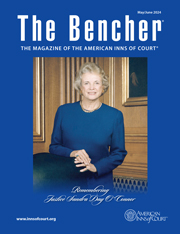Courts Can Adapt with Technology and Improve Practitioners’ Experience
The Bencher—May/June 2024
By Raffi Melkonian, Esquire

 The U.S. Court of Appeals for the Fifth Circuit has often found itself in the news this past year, whether it’s for important decisions on fraught social issues (such as abortion medications and border crossings) or for its continued grappling with more local disputes (such as the spate of lawsuits about Louisiana’s “overdetention” of prisoners past the end of their sentences).
The U.S. Court of Appeals for the Fifth Circuit has often found itself in the news this past year, whether it’s for important decisions on fraught social issues (such as abortion medications and border crossings) or for its continued grappling with more local disputes (such as the spate of lawsuits about Louisiana’s “overdetention” of prisoners past the end of their sentences).
All that aside, the court has been making technological advancements that improve the day-to-day practice of lawyers in the circuit. The court’s example could be adopted by other courts throughout the country; courts may be loathe to make big changes, but they can still make incremental reforms to improve the judicial process.
The Fifth Circuit’s new “Attorney Toolbox” is a wonderful example of the trend. The court has long offered its judges hyperlinked copies of briefs. After the litigants filed their briefs, an internal court program linked all cases cited by the parties to the Westlaw or LEXIS databases and all record citations to the Fifth Circuit’s Record on Appeal. That way, judges could simply click on a case on their tablets or computer screens and be taken directly to the cited authority.
The Record on Appeal in turn was automatically generated by the court from the entire district court record: in the Fifth Circuit, you needn’t worry about manually creating a voluminous appellate appendix the way you do in other courts. Instead, the district court produces a paginated PDF document that includes every document filed in the trial court.
As welcome as these systems were, however, many Fifth Circuit lawyers worried about exactly how the citations would appear in the internal documents the judges would review. For example, when they clicked on page 454 of the Record on Appeal—the page with the key contractual provision—would it go to the correct page or would the link be broken?
The court’s filing system also had pitfalls for less-experienced lawyers. The court requires parties to file so-called “Record Excerpts,” which is a short selection of record materials primarily intended for a screening panel to decide whether a case merits oral argument. But many novice counsel included the wrong documents in the excerpts, leading to their briefs being rejected. Such rejections can be embarrassing but also cost clients needless money.
All that has now changed with the toolbox. Once you’re done writing, the court’s own system will hyperlink your cases to a legal database of choice. The system will also hyperlink your brief to the Record on Appeal. This solves the concern about not being able to check the final product. Lawyers now will be able to see exactly what the Fifth Circuit judges see. In addition, the toolbox will automatically generate the required Record Excerpts. This automatic functionality should help reduce the number of record excerpts that are rejected by the court for failing to conform to the rules. And if all that fails, the Fifth Circuit has also relatively recently instituted an automatic three-day emergency extension. This gives you extra time if on a due date you find yourself unable to file because of technological problems.
These are not necessarily world-changing innovations, but because courts often sit above the fray of litigation, sometimes they forget to change with the times. All around the country, courts maintain outdated procedures or fail to take advantage of new technology. What my Fifth Circuit anecdote shows is that it’s possible for an innovative court to improve things in small ways that can have significant effects.
To be sure, that doesn’t mean that every court should adopt an attorney toolbox or an emergency extension program. Local circumstances might require more locally focused reforms. For example, the Texas judiciary recently eliminated the need for certificates of service. Given the Texas e-filing system, they were obsolete. Other courts might be able to ensure that litigants get electronic service of decisions rather than waiting on postcards mailed from the court. There might also be a way to set hearing dates in busy trial courts faster and without taking the court staff away from their duties. What is clear, however, is that there are many small improvements that can have big effects. All of us should be looking for opportunities to make those changes.
Raffi Melkonian, Esquire, is an appellate partner at the Houston, Texas, law firm of Wright, Close & Barger LLP. He litigates appeals in the state and federal courts of Texas and around the United States. He can be reached at melkonian@wrightclosebarger.com. Melkonian is Master of the Bench member of the Garland R. Walker American Inn of Court.